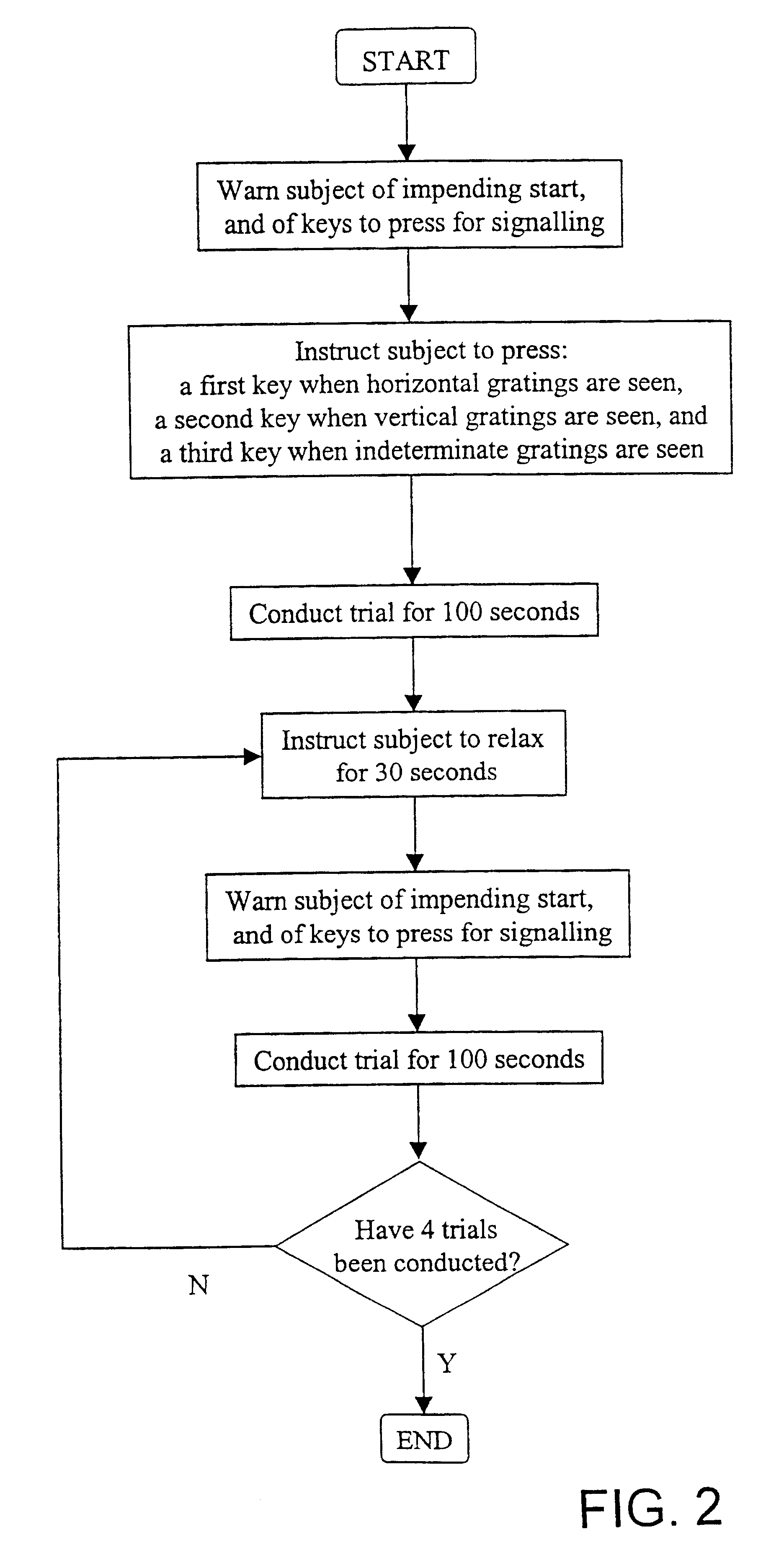Method and apparatus for diagnosis of a mood disorder or predisposition therefor
a mood disorder and diagnosis technology, applied in the field of mood disorders, can solve problems such as complex genetics, and achieve the effects of reducing the effect, reducing the effect, and increasing the absolute magnitude of chang
- Summary
- Abstract
- Description
- Claims
- Application Information
AI Technical Summary
Benefits of technology
Problems solved by technology
Method used
Image
Examples
example 1
Apparatus for Measuring Rate of Binocular Rivalry
In one embodiment shown in FIG. 1, binocular rivalry is used as an indicator of mood disorder or predisposition therefor. Binocular rivalry is tested with a subject 1 seated three metres from a computer monitor 2 and wearing liquid crystal shutter goggles 3 to enable the presentation of vertical moving lines 4 to the left eye and horizontal moving lines 5 to the right eye. The stimuli subtend 1.5 degrees of visual angle with a spatial frequency of 8 cycles / degree moving at 4 cycles / second. The subject 1 presses one of three response buttons 6 to indicate their perceptual state (horizontal, vertical or mixed / indeterminate percepts). Rivalry testing is conducted over half an hour. There are three blocks of testing, each containing four 100 second trials interspersed with 30 second rests. Each block is interspersed with a two-minute rest. A non-limiting example of a block of testing is given in FIG. 2.
Alternation rate per second is calcu...
example 2
Linkage Studies
The inventors' discovery of slow rivalry alternation rate in individuals with bipolar disorder, and in particular, relatives of individuals with such disorder, is potentially a major breakthrough in understanding the genetics of the disorder. There is no doubt that bipolar disorder is strongly heritable (Mitchell et al, 1993, Aust. & New Zeal. J. Psych. 27:560).
The identification of a trait-dependent marker for bipolar disorder will assist genetic linkage studies, and may lead to the identification of the underlying molecular defect. Gershon and Goldin (1986, Acta Psych Scand 74:113) proposed four basic criteria for markers to be considered risk factors for disease:
i. The biological variable should be associated with the disease at the population level and should clearly separate patients from controls;
ii. Family and twin studies should confirm that the variable is heritable;
iii. It should be a trait rather than a state marker, present in both the acute phase and in r...
example 3
Identifying a Candidate Therapeutic Agent for Alleviating or Preventing Mood Disorders (I)
Binocular Rivalry in Monkeys Detected by their Behavioural Response.
Macaca mulatta monkeys are trained, while wearing liquid crystal shutter goggles, to fixate on a light spot on a computer monitor. They are then taught to pull and hold one of two levers if vertical moving lines are presented to both eyes, and to pull and hold a different lever if horizontal moving lines are presented to both eyes. In addition, they are trained not to respond to the presentation of different blends of horizontal and vertical moving lines. The stimuli subtend 1.5 degrees of visual angle with a spatial frequency of 8 cycles / degree moving at 4 cycles / second. Rewards of juice are provided for successful identification of visual stimuli during periods of random presentation of horizontal moving lines, vertical moving lines, or blended horizontal and vertical moving lines. When animals can accurately identify the dif...
PUM
 Login to View More
Login to View More Abstract
Description
Claims
Application Information
 Login to View More
Login to View More - R&D
- Intellectual Property
- Life Sciences
- Materials
- Tech Scout
- Unparalleled Data Quality
- Higher Quality Content
- 60% Fewer Hallucinations
Browse by: Latest US Patents, China's latest patents, Technical Efficacy Thesaurus, Application Domain, Technology Topic, Popular Technical Reports.
© 2025 PatSnap. All rights reserved.Legal|Privacy policy|Modern Slavery Act Transparency Statement|Sitemap|About US| Contact US: help@patsnap.com



